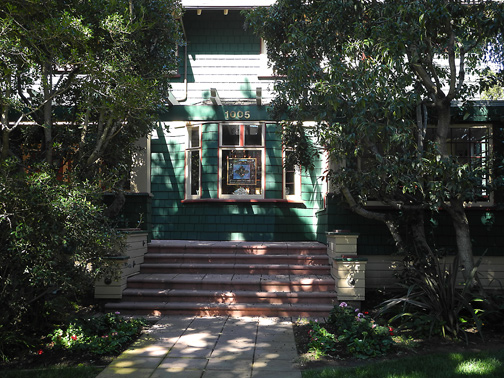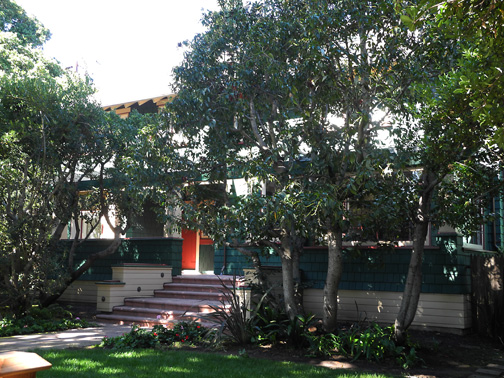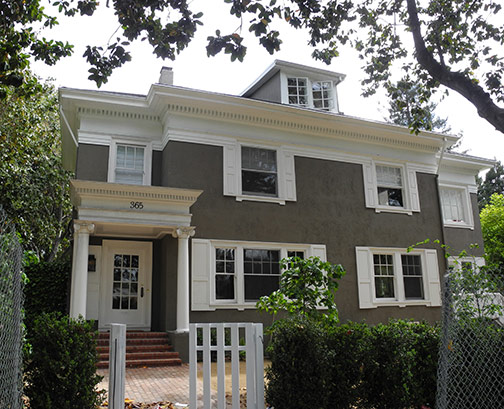 Palo Alto Stanford Heritage
Palo Alto Stanford Heritage 
Originally part of the Rancho Rinconada Del Arroyo de San Francisquito, the Crescent Park neighborhood was first developed in 1887 when Timothy Hopkins purchased 698 acres to accommodate Leland Stanford’s desire for a “dry” university town. Hopkins’ lots sold like hot cakes for between $122.50 and $287. In 1901 Edwin and Louisa Braunschweiger bought a 100 x 200 square foot plot at the corner of University and Hale Streets from Hopkins. Both came from prosperous German families who had immigrated to the Bay Area in the nineteenth century. Edwin, along with his brother, Herman, owned Braunschweiger & Co., a San Francisco importer and wholesaler of wine and liquor. The Braunschweigers moved into the University Avenue house in 1902 and lived there with their children, Elyse, Viola, Herman and Stanford grad, Edward until 1918, four years after Edwin’s death.

Louisa and Edwin hired James Webster Wells (1854–1924), a noted local builder, to construct their house in the Craftsman style. Wells, who was born in New Hampshire, came to Palo Alto with his wife in 1892. Initially he built numerous small square cottages in the pioneer town, such as the one at 892 Homer Avenue. As his reputation for fine craftsmanship grew, he was commissioned to build more significant houses, such as the 1897 house at 501 Kingsley Avenue in Professorville. Perhaps his most recognized is the 1899 Sunbonnet house at 1061 Bryant Street, which was designed by Bernard Maybeck. Wells’ own home, a large Renaissance and Baroque inspired structure at 365 Guinda Street is eligible for the National Register of Historic Places.

The Braunschweiger house, at 4,851 square feet, cost $5,000 to construct, making it one of the most expensive built in Palo Alto in 1902. The house is typical of the early California Craftsman style. Rectangular in shape with heavy massing, its complex roof with intersecting hips has overhanging eaves and exposed rafter tails. Shingle siding, asymmetrical fenestration and porch details are characteristic Craftsman. Four chamfered bay windows, a picture window and an assortment of asymmetrically placed smaller windows are wood framed and have hand hammered openers. The most unusual window in the house is the eyebrow dormer vent at the attic level. At the 2nd story left, there was an open sleeping porch, now enclosed, which overhangs the first floor.
Wide steps lead to a porch whose four square Craftsman pillars rest on a shingled balustrade and support a trellised roof. The paneled entry door, in a porch recess, has a wrought iron “speakeasy grill” or peephole seen in upscale Craftsman houses. The foyer leads at either side to the living and dining rooms, but it is the angled staircase that is the center of attention. With its Craftsman newel post topped by a light fixture and combined with more Classical urn-like turned balusters, it creates an atmosphere of elegance.
A balustrade in the 2nd floor hallway above the staircase landing has a window behind it which bathes the foyer with light. The dining room to the right of the foyer, with its bay window, coved ceiling and oak floors, leads both to a study beyond and to the kitchen/great room in the rear.
A wider entrance to the living room at the right of the foyer accesses the living room. Originally two rooms, it is now the full length of the house. A rear wall fireplace of small, smooth bricks has decorative detailing of larger rough bricks and egg and dart molding beneath its simple wood mantel. The high ceilings throughout the house are coved. Because the cove is less deep than normally seen, a delicate effect is created.
Over the years, a series of owners renovated 1005 University. An example was the 1950’s craze to replace the original shingle siding with stucco. It wasn’t until Diana Tasca and Norm Beamer bought the house in 1992 that the shingle exterior was restored and a process of rehabilitation began. Even after a 2010 fire gutted the roof and upper story, they salvaged historic features including interior staircase spindles and trim. Tasca, the Artistic Director of the award-winning Pear Theatre in Mountain View, and Beamer, an attorney and President of the Crescent Park Neighborhood Association, also secured the house’s placement on Palo Alto’s Historic Inventory.
| |
E-mail us at either webmaster@pastheritage.org or president@pastheritage.org.
![]() Palo Alto Stanford Heritage—Dedicated to the preservation of Palo Alto's historic buildings.
Palo Alto Stanford Heritage—Dedicated to the preservation of Palo Alto's historic buildings.
Copyright © 2015 Palo Alto Stanford Heritage. All rights reserved.
Last updated on 04/20/2019 16:41:27